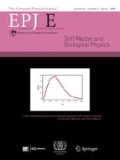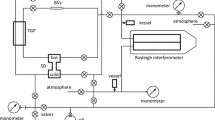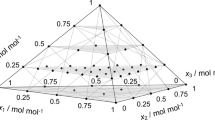Abstract.
In multicomponent mixtures, a much richer variety of phenomena can occur than in simple (single-component) fluids. Natural convection in single-component fluids is due to buoyancy forces caused by temperature gradients. In multicomponent mixtures, buoyancy forces may also be caused by concentration gradients. Because natural convection, molecular diffusion, and thermal conduction have different relaxation time scales, a wide variety of resulting convective motions and heat and mass distributions might occur. In some fluid mixtures such as water-ethanol system, for instance, ethanol diffuses much more slowly than heat, and because of this difference in time scales oscillatory convection might occur. In a multicomponent mixture, the total molar flux consists of two parts: the convective molar flux and the diffusive molar flux (resulting from the difference between the component velocity and the bulk velocity). The diffusion molar flux of a component depends, not only on its own mole fraction gradient (Fickian diffusion), but also on the gradient of all the components present in the mixture (cross-molecular diffusion). The diffusion flux depends also on the pressure gradient (pressure diffusion; the so-called gravitational effect) and temperature gradient (thermal diffusion; the so-called Soret effect). Firoozabadi’s thermal diffusion model was applied to calculate the Soret coefficient, as well as the thermal diffusion coefficient and molecular diffusion coefficient for methanol-water and ethanol-water mixtures at 310.65 K temperature and 1 bar pressure with 10% water mass fraction. The results were compared with experimental data (J.K. Platten, in Proceedings of the 5th International Meeting on Thermodiffusion (IMT5), Lyngby, Aug. 2002, Philos. Mag. 83, Nos. 17-18 (2003)), as well as theoretical predictions with other models. A better agreement with the experimental data using the Firoozabadi model was achieved.
Similar content being viewed by others
References
C. Ludwig, Sitzungsber. Akad. Wiss. Wien Math.-Naturwiss. Kl. 20, 539 (1856).
C. Soret, Arch. Sci. Phys. Nat. Genève 3, 48 (1879).
R. Haase, Phys. Chem. 196, 219 (1950).
W.M. Rutherford, H.G. Drickamer, J. Chem. Phys. 22, 1157 (1954).
E.L. Dougherty, H.G. Drickamer, J. Phys. Chem. 59, 443 (1955).
L.J.T.M. Kempers, J. Chem. Phys. 90, 6541 (1989).
K. Shukla, A. Firoozabadi, Ind. Eng. Chem. Res. 37, 3331 (1998).
J.K. Platten, in Proceedings of the 5th International Meeting on Thermodiffusion (IMT5), Lyngby, Aug. 2002, Philos. Mag. 83, Nos. 17-18 (2003).
L. Onsager, Phys. Rev. 37, 405 (1931).
R. Taylor, R. Krishna, Multicomponent Mass Transfer (Wiley, New York, 1993).
K.G. Denbigh, The Thermodynamics of The Steady State (Methuen & Co. Ltd., London, 1951).
M.S. Wertheim, J. Chem. Phys. 87, 7323 (1987).
W.G. Chapman, Fluid Phase Equilibria 52, 31 (1998).
M.L. Michelsen, E.M. Hendriks, Fluid Phase Equilibria 180, 165 (2001).
G.M. Kontogeorgis, Fluid Phase Equilibria 158-160, 201 (1999).
S.H. Huang, M. Radosz, Ind. Eng. Chem. Res. 29, 2284 (1990).
Author information
Authors and Affiliations
Corresponding author
Rights and permissions
About this article
Cite this article
Saghir, M.Z., Jiang, C.G., Derawi, S.O. et al. Theoretical and experimental comparison of the Soret coefficient for water-methanol and water-ethanol binary mixtures. Eur. Phys. J. E 15, 241–247 (2004). https://doi.org/10.1140/epje/i2004-10063-7
Received:
Accepted:
Published:
Issue Date:
DOI: https://doi.org/10.1140/epje/i2004-10063-7




